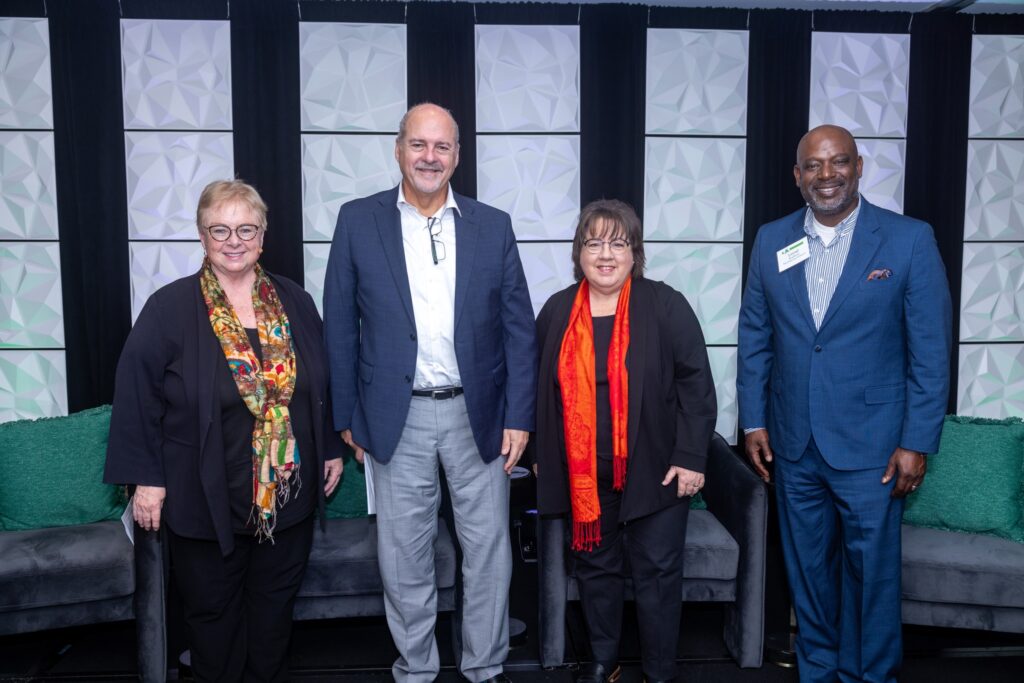Redesigning Marine Propellers with the Environment in Mind

Sharrow Marine, headquartered in St. Clair Shores, Michigan, is focused on marine propulsion technology. In 2024, the company’s Sharrow Propeller™ was recognized as a finalist in Fast Company’s Best World Changing Ideas North America award category. The awards honor businesses and organizations that are developing creative solutions for “the most pressing issues of our time.” SBND recently interviewed Greg Sharrow, CEO and inventor of the Sharrow Propeller, about the company’s technology and its impact on the environment and the marine industry. Q: Tell us about Sharrow Marine and your propellers. A: Sharrow Marine designs and manufactures propeller technology. Our propeller – recognized as the first major advancement in propeller design since the 1830s – eliminates the traditional propeller tip vortices, which are a major source of energy loss. This “tip-less” design leads to a 30% increase in efficiency and reduces underwater noise by up to 80%, making it quieter than conventional propellers. From a sustainability standpoint, this means less fuel consumption, reduced noise pollution in marine environments, and lower carbon emissions. Q: How does your propeller design directly impact sustainability in the marine industry? A: Every one of our propellers is designed for a specific application, and our process allows us to predict thrust within these applications and design for maximum efficiency. This, in turn, reduces the amount of fuel a vessel needs to operate. A lot of the fuel burned in the tanker industry, for example, is bunker fuel, which is a less refined, high-sulfur fuel. By reducing the fuel required, we not only cut carbon emissions but also reduce the pollutants entering the water. This approach creates a significant positive impact on the marine ecosystem. Q: How does the increased fuel economy of your propellers translate to measurable reductions in carbon emissions? A: The math is straightforward – burn less fuel and emit less carbon. Our propellers are about 30% more fuel-efficient, which means a corresponding 30% reduction in carbon emissions. For fleet operators and the recreational boating community, this translates to significant savings and a smaller environmental footprint. Q: What challenges did you face in developing this product? A: The biggest challenge was essentially rewriting the book on propeller design. We had to develop entirely new theories of operation and create software to test thousands of designs quickly. Assembling a team of engineers and software experts to write the code was a feat, but we now have an incredible team. Another hurdle was manufacturing. Each propeller requires its own program and a multistep production process. Finding a manufacturing partner who could handle such complexity wasn’t easy. I traveled the world and ended up finding the right partner in my backyard, which is not surprising seeing as Detroit is the place for manufacturing. We were fortunate to partner with Detroit Dynamics. They’ve been incredible in helping us establish a fully functional manufacturing facility here in Detroit. Q: Beyond fuel efficiency and emissions, what other sustainability benefits does your propeller technology offer? A: Noise reduction is a big one. The noise pollution in our oceans that is created by cavitation generated from traditional propellers has a devastating effect on marine wildlife. Our technology reduces underwater noise by 3–15 decibels on average, which helps protect marine ecosystems. Additionally, all of our materials are sourced within the United States, further minimizing our carbon footprint and supporting local economies. In terms of sustainability in Southeast Michigan, Detroit is integral to who we are. This city has a rich history of engineering and manufacturing expertise, and we’re proud to be a part of that legacy. All our propellers are manufactured here in Detroit, creating jobs and supporting the local economy. Q: What opportunities does your technology present for fleet operators and recreational boaters? A: For fleet operators, the savings in fuel costs are massive, and for recreational boaters, the benefits go beyond fuel efficiency. Our propellers reduce vibration and noise, improve high-speed control, and make docking in tight quarters much easier. For the average boater who logs about 52 hours a year, the return on investment starts the moment they turn the key. Q: How do you see Sharrow Propellers contributing to the broader efforts to decarbonize the marine industry? A: We’ve already established a strong footprint in the outboard motor market, but the inboard motor market – specifically for blue water and oceanic vessels – represents a massive opportunity. These vessels are some of the biggest polluters due to their reliance on bunker fuel. By applying our technology to this segment, we can significantly reduce sulfur emissions and improve fuel efficiency, effectively decarbonizing a critical part of the industry. We’re also partnering with VEEM in Australia to bring our innovations to the global market and are in the process of growing to full production scale of the SHARROW by VEEM. Q: Looking ahead, how do you see your propeller technology fitting into broader sustainability efforts? A: We’ve been focused on the marine industry, but interestingly, the propeller was originally developed for use in the air. So, as we move forward, expanding into renewable energy applications is a priority. Whether it’s wind turbines, hydro-energy, or further innovations in marine propulsion, our goal is to make a meaningful impact on how energy is generated and consumed. Be sure to subscribe to our newsletter for regular updates on sustainable business practices in and around Detroit.
Restoring Detroit’s Tree Canopy

Detroit was once known as the “city of trees,” but disease, invasive insects, and budget cuts over time have decimated our area’s distinctive tree canopy. But efforts are underway to replenish trees while also providing job training, green spaces, education, and community engagement. On Oct. 31, 2024, Sustainable Business Network Detroit hosted an informative discussion sponsored by the Fred and Barbara Erb Family Foundation regarding these efforts and how restoring tree canopy benefits individuals, neighborhoods, businesses, and the economy. The panelists were: Lionel Bradford, president and executive director, Greening of Detroit, a nonprofit focused on enhancing the quality of life for Detroiters by planting trees, providing job training, and involving youth in the education of the natural environment. It involves Detroiters in the process through community engagement, green spaces, education, and jobs. Maureen Donohue Krauss, president and CEO, Detroit Regional Partnership. DRP works to serve as a single point of contact for information, connection to services, incentives, and data for businesses who want to locate or expand in the 11-county Southeast Michigan Region. Robert Riney, president and CEO, Henry Ford Health, and leader of HFH’s $4 billion Destination: Grand initiative. The project includes a $2.2 billion expansion of HFH’s Detroit campus anchored by a new state-of-the-art hospital facility that will span 1.2 million square feet. It includes a 20-story patient tower, with three floors dedicated to providing intensive inpatient physical medicine and rehabilitation in partnership with the Shirley Ryan AbilityLab and its own Central Energy Hub, making it one of the largest fully electric-capable hospitals in the country. The event was moderated by Terry Barclay, president and CEO of Inforum, and chair of SBN Detroit. Some of the takeaways: The case for tree canopy Lionel: Growing up in Southeast Louisiana – which is very hot – you quickly learn the value of a tree. It’s also a sportsman’s paradise – We did a lot of hunting, fishing, and camping, and I developed a great appreciation for the environment and its value. I also love people. The work that we do is about people at the end of the day, so when we do this work it’s to build community and neighborhoods. We try our very best – changing landscapes and lives is our motto. When someone has been incarcerated for 20 years and needs a second chance, they can come through your program – the Detroit Conservation Corps – and they can be trained and support their families. You can train people to put trees in the ground and maintain them. Maureen: Part of my role is to inform people that economic development is more than just a new factory in your town, more than just a tax abatement. It’s creating an environment that both people and companies want to be in. Sixty percent of our projects are from international companies – when people come here for the first time, they have expectations of what a first-class city looks like… Think about Paris and its phenomenal tree canopies. People want that here. I did a little research before this event: Homes with trees sell two days faster and for 15% more than homes without. Tree value increases with age – the cost of trees has 100% payback. Three properly placed trees can reduce air conditioning by 56% and reduce home heating bills by 10% by serving as a windbreak. Bob: You may think what does a healthcare system have to do with tree canopies? HFH is absolutely committed to increasing the health of communities – the role that hospitals and doctors play is about 20%. We don’t underestimate the power of that 20%, but true health – meaning how long people will live and have a high-value life – is a partnership of healthcare, policy, and environmental factors – which are huge. You may have seen that the biggest determinant of your health is the ZIP Code that you live in. You need to have fabulous healthcare, access to it, economic security, environmental security, and food and nutrition security. At HFH we need to be a population health company – we pick and choose how we should make our mark and one of the things we believe in is the power of the tree. We have to walk the talk. The economic benefits of tree canopy Maureen: Our organization has three pillars: market, grow, and support. It’s so much better now. People are curious to hear about Detroit and see what’s happening. Talent is No. 1 – we have the second-highest amount of engineers in the country and have experienced manufacturing talent. As one of my teammates says, it’s workforce, weather, and water. When you talk about climate change, Michigan will be in the top five least affected. The right amount of tree canopy and how trees are sourced Lionel: American Forests did a study and determined that a city the size of Detroit should be at 40%. Right now we’re at 26%. We lose about 2,000 trees a year, so those have to be taken into account. We get most of our trees from New York and Indiana and, more recently, Wholesale Tree Inc. in Northern Michigan. More importantly, we’re growing our own trees now – running the Walter Meyers Nursery in Rouge Park, which is owned by the city. We’re very intentional about turning into a full-fledged operational business. Last year, we harvested our first set of trees. We have lost a lot of trees over time, and the reason we have lost a lot of those is because the city lacked the resources, and dead trees were not removed and were taken down by storms. This administration has done a great job by taking trees down when dead and dying. Working with DTE has been quite thrilling – they have given financial support to planting trees but also to making sure that the next generation of environmental stewards are trained by supporting our Green Corps summer programs and also the tree


